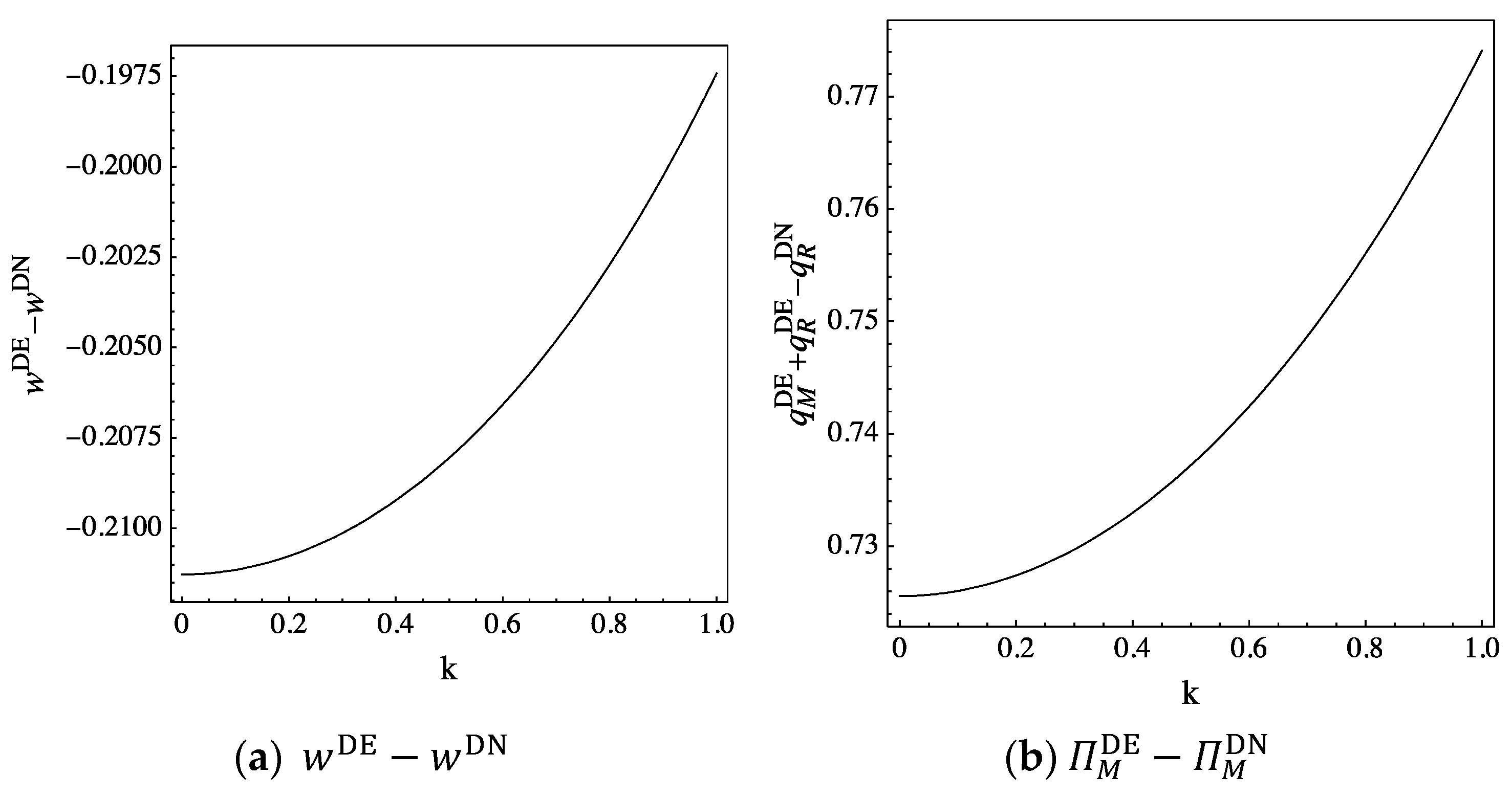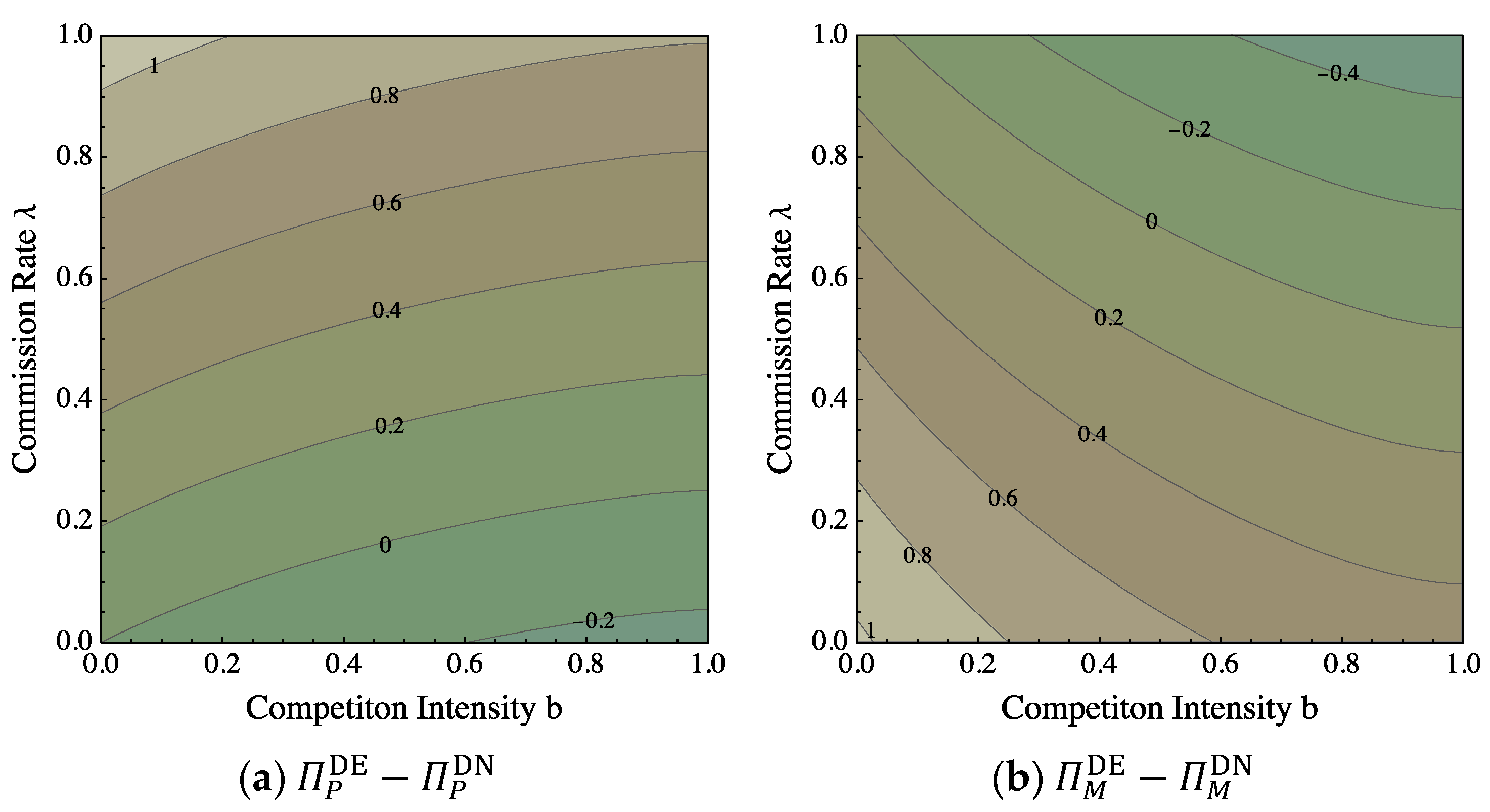Investment in Data Analytics with Manufacturer Encroachment
Abstract
1. Introduction
1.1. Motivation and Research Background
1.2. Research Questions and Major Findings
- What are the manufacturer’s and the platform’s equilibrium decisions (such as wholesale price and selling quantity) under different scenarios?
- How do the manufacturer’s and the platform’s equilibrium decisions depend on the agency channel’s commission rate and competition intensity?
- How does data analytics capability investment interact with the manufacturer’s encroachment decision of whether or not to add an agency channel to an existing reselling channel on the online retail platform?
2. Literature Review
2.1. Data Analytics
2.2. Manufacturer Encroachment
2.3. Channel Structure
3. Modeling Framework
4. Equilibrium Results
4.1. No Data Analytics and No Encroachment (NN)
4.2. No Data Analytics and Encroachment (NE)
4.3. Data Analytics and No Encroachment (DN)
4.4. Data Analytics and Encroachment (DE)
5. Decision Analyses
5.1. Encroachment Decisions
5.2. Data Analytics Investment Decisions
6. Conclusions
Author Contributions
Funding
Data Availability Statement
Conflicts of Interest
Appendix A
References
- Cohen, M.C. Big Data and Service Operations. Prod. Oper. Manag. 2018, 27, 1709–1723. [Google Scholar] [CrossRef]
- Curko, K.; Silovic, T.; Merkas, Z. Challenges of Application of the Big Data in Marketing: Case Study Croatia. WSEAS Trans. Bus. Econ. 2018, 15, 162–170. [Google Scholar]
- Choi, T.M.; Wallace, S.W.; Wang, Y. Big Data Analytics in Operations Management. Prod. Oper. Manag. 2018, 27, 1868–1883. [Google Scholar] [CrossRef]
- Kumar, S.; Mookerjee, V.; Shubham, A. Research in Operations Management and Information Systems Interface. Prod. Oper. Manag. 2018, 27, 1893–1905. [Google Scholar] [CrossRef]
- Feng, Q.; Shanthikumar, J.G. How Research in Production and Operations Management May Evolve in the Era of Big Data. Prod. Oper. Manag. 2018, 27, 1670–1684. [Google Scholar] [CrossRef]
- Rust, R.T.; Huang, M.-H. The Service Revolution and the Transformation of Marketing Science. Mark. Sci. 2014, 33, 206–221. [Google Scholar] [CrossRef]
- Jiang, H.; Qi, X.; Sun, H. Choice-Based Recommender Systems: A Unified Approach to Achieving Relevancy and Diversity. Oper. Res. 2014, 62, 973–993. [Google Scholar] [CrossRef]
- Besbes, O.; Gur, Y.; Zeevi, A. Optimization in Online Content Recommendation Services: Beyond Click-through Rates. Manuf. Serv. Oper. Manag. 2016, 18, 15–33. [Google Scholar] [CrossRef]
- Singhal, K.; Feng, Q.; Ganeshan, R.; Sanders, N.R.; Shanthikumar, J.G. Introduction to the Special Issue on Perspectives on Big Data. Prod. Oper. Manag. 2018, 27, 1639–1641. [Google Scholar] [CrossRef]
- Lutfi, A.; Alrawad, M.; Alsyouf, A.; Almaiah, M.A.; Al-Khasawneh, A.; Al-Khasawneh, A.L.; Alshira’h, A.F.; Alshirah, M.H.; Saad, M.; Ibrahim, N. Drivers and Impact of Big Data Analytic Adoption in the Retail Industry: A Quantitative Investigation Applying Structural Equation Modeling. J. Retail. Consum. Serv. 2023, 70, 103129. [Google Scholar] [CrossRef]
- Ghoshal, A.; Kumar, S.; Mookerjee, V. Dilemma of Data Sharing Alliance: When Do Competing Personalizing and Non-personalizing Firms Share Data. Prod. Oper. Manag. 2020, 29, 1918–1936. [Google Scholar] [CrossRef]
- Liu, W.; Yan, X.; Li, X.; Wei, W. The Impacts of Market Size and Data-Driven Marketing on the Sales Mode Selection in an Internet Platform Based Supply Chain. Transp. Res. Logist. Transp. Rev. 2020, 136, 101914. [Google Scholar] [CrossRef]
- Zhang, Z.; Shivendu, S.; Wang, P. Is Investment in Data Analytics Always Profitable? The Case of Third-Party-Online-Promotion Marketplace. Prod. Oper. Manag. 2021, 30, 2321–2337. [Google Scholar] [CrossRef]
- Chiang, W.K.; Chhajed, D.; Hess, J.D. Direct Marketing, Indirect Profits: A Strategic Analysis of Dual-Channel Supply-Chain Design. Manage Sci. 2003, 49, 1–20. [Google Scholar] [CrossRef]
- Arya, A.; Mittendorf, B.; Sappington, D.E.M. The Bright Side of Supplier Encroachment. Mark. Sci. 2007, 26, 651–659. [Google Scholar] [CrossRef]
- Li, Z.; Gilbert, S.M.; Lai, G. Supplier Encroachment under Asymmetric Information. Manage Sci. 2014, 60, 449–462. [Google Scholar] [CrossRef]
- Li, Z.; Gilbert, S.M.; Lai, G. Supplier Encroachment as an Enhancement or a Hindrance to Nonlinear Pricing. Prod. Oper. Manag. 2015, 24, 89–109. [Google Scholar] [CrossRef]
- Yoon, D. Supplier Encroachment and Investment Spillovers. Prod. Oper. Manag. 2016, 25, 1839–1854. [Google Scholar] [CrossRef]
- Yang, H.; Luo, J.; Zhang, Q. Supplier Encroachment under Nonlinear Pricing with Imperfect Substitutes: Bargaining Power versus Revenue-Sharing. Eur. J. Oper. Res. 2018, 267, 1089–1101. [Google Scholar] [CrossRef]
- Zhang, J.; Cao, Q.; He, X. Manufacturer Encroachment with Advertising. Omega (Westport) 2020, 91, 102013. [Google Scholar] [CrossRef]
- Gao, L.; Guo, L.; Orsdemir, A. Dual-channel Distribution: The Case for Cost Information Asymmetry. Prod. Oper. Manag. 2021, 30, 494–521. [Google Scholar] [CrossRef]
- Ha, A.Y.; Luo, H.; Shang, W. Supplier Encroachment, Information Sharing, and Channel Structure in Online Retail Platforms. Prod. Oper. Manag. 2022, 31, 1235–1251. [Google Scholar] [CrossRef]
- Guan, H.; Yang, Z.; Gurnani, H. Value of Information with Manufacturer Encroachment. Prod. Oper. Manag. 2023, 32, 780–793. [Google Scholar] [CrossRef]
- Huang, S.; Chen, Y. Manufacturer Encroachment with Competing Dual-Purpose Online Retail Platforms. J. Retail. Consum. Serv. 2023, 73, 103370. [Google Scholar] [CrossRef]
- Shi, S.; Wang, C.; Cheng, T.C.E.; Liu, S. Manufacturer Encroachment with an E-commerce Division. Prod. Oper. Manag. 2023, 32, 2002–2019. [Google Scholar] [CrossRef]
- Hagiu, A.; Wright, J. Marketplace or Reseller? Manag. Sci. 2015, 61, 184–203. [Google Scholar] [CrossRef]
- Abhishek, V.; Jerath, K.; Zhang, Z.J. Agency Selling or Reselling? Channel Structures in Electronic Retailing. Manag. Sci. 2016, 62, 2259–2280. [Google Scholar] [CrossRef]
- Kwark, Y.; Chen, J.; Raghunathan, S. Platform or Wholesale? A Strategic Tool for Online Retailers to Benefit from Third-Party Information. MIS Q. 2017, 41, 763–786, A1–A17. [Google Scholar] [CrossRef]
- Tian, L.; Vakharia, A.J.; Tan, Y.; Xu, Y. Marketplace, Reseller, or Hybrid: Strategic Analysis of an Emerging E-commerce Model. Prod. Oper. Manag. 2018, 27, 1595–1610. [Google Scholar] [CrossRef]
- Jerath, K.; Zhang, Z.J. Platform Retailing: From Offline “Stores within a Store” to Online “Marketplaces”. In Handbook of Research on Distribution Channels; Edward Elgar Publishing: Cheltenham, UK, 2019; pp. 52–74. [Google Scholar]
- Ha, A.Y.; Tong, S.; Wang, Y. Channel Structures of Online Retail Platforms. Manuf. Serv. Oper. Manag. 2022, 24, 1547–1561. [Google Scholar] [CrossRef]
- Cao, Q.; Geng, X.; Zhang, J. Impact of Channel Structure on a Manufacturer’s Bundling Decision with an Application to Digital Goods. Prod. Oper. Manag. 2022, 31, 1679–1697. [Google Scholar] [CrossRef]
- Zhen, X.; Xu, S. Who Should Introduce the Third-Party Platform Channel under Different Pricing Strategies? Eur. J. Oper. Res. 2022, 299, 168–182. [Google Scholar] [CrossRef]
- Hong, X.; Gong, Y.; Rekik, Y.; Li, Q. Public versus Private Information: The Impact of Quality Information Sharing on Competition under Different Channel Structures. Comput. Ind. Eng. 2023, 176, 108937. [Google Scholar] [CrossRef]
- Hotkar, P.; Gilbert, S.M. Supplier Encroachment in a Nonexclusive Reselling Channel. Manage Sci. 2021, 67, 5821–5837. [Google Scholar] [CrossRef]




| Parameters | Description |
| Subscripts representing reselling channel and agency channel, respectively | |
| No data analytics and no encroachment | |
| No data analytics and encroachment | |
| Data analytics and no encroachment | |
| Data analytics and encroachment | |
| Potential market size | |
| Competition intensity | |
| Marginal investment cost | |
| Wholesale price | |
| Consumers’ sensitivity to personalized recommendation | |
| Commission rate | |
| Data analytics investment level | |
| Selling quantity | |
| Selling price | |
| Profit of the manufacturer | |
| Profit of the platform |
Disclaimer/Publisher’s Note: The statements, opinions and data contained in all publications are solely those of the individual author(s) and contributor(s) and not of MDPI and/or the editor(s). MDPI and/or the editor(s) disclaim responsibility for any injury to people or property resulting from any ideas, methods, instructions or products referred to in the content. |
© 2024 by the authors. Licensee MDPI, Basel, Switzerland. This article is an open access article distributed under the terms and conditions of the Creative Commons Attribution (CC BY) license (https://creativecommons.org/licenses/by/4.0/).
Share and Cite
Han, F.; Guan, J. Investment in Data Analytics with Manufacturer Encroachment. Mathematics 2024, 12, 1371. https://doi.org/10.3390/math12091371
Han F, Guan J. Investment in Data Analytics with Manufacturer Encroachment. Mathematics. 2024; 12(9):1371. https://doi.org/10.3390/math12091371
Chicago/Turabian StyleHan, Feifei, and Jiao Guan. 2024. "Investment in Data Analytics with Manufacturer Encroachment" Mathematics 12, no. 9: 1371. https://doi.org/10.3390/math12091371
APA StyleHan, F., & Guan, J. (2024). Investment in Data Analytics with Manufacturer Encroachment. Mathematics, 12(9), 1371. https://doi.org/10.3390/math12091371






